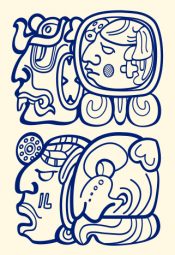Let me take this opportunity to announce that our blogs will now follow a schedule of every two winals or 40 days, so that the day Ajaw will remain the same, while the number of the day will advance by one. Floyd Lounsbury noted that the Jakaltek Maya refer to this as the “Steps of the Year” or U Yok Habil. Today’s date is 4 Ajaw 3 Xul, while the subsequent blog will follow on 5 Ajaw 3 Mol, August 22, followed by 6 Ajaw 3 Yax on October 1, etc. This gives us an easy progression to follow, while allowing ample time for our colleagues to report back from the field.
Today, the auspicious day of 4 Ajaw commemorates the same Tzolk’in day of the Long Count Era Base on 4 Ajaw 8 Kumk’u, mentioned with reverence throughout the inscriptions of the Classic Period as a day of renewal.
Quiero aprovechar esta oportunidad para anunciar que nuestros blogs aparecerán ahora cada dos winales o 40 días, por lo que el día Ajaw será siempre el mismo, pero el número de día avanzará una posición. Floyd Lounsbury señaló que los mayas jakaltecos se referían a esto como “Los Pasos del Año,” U Yok Habil. La fecha de hoy es 4 Ajaw 3 Xul, y el siguiente blog aparecerá en la fecha 5 Ajaw 3 Mol, o 22 de agosto, seguido de la fecha 6 Ajaw 3 Yax el 1º de octubre, etc. Esto marcará el avance del tiempo de una manera fácil de seguir, y también dará más tiempo a nuestros colegas para recopilar y enviar su información de campo.
El día de hoy, que cae en la auspiciosa fecha 4 Ajaw, conmemora el mismo día del tzolk’in de la Fecha Base de la Cuenta Larga, 4 Ajaw 8 Kumk’u, que se menciona con reverencia en las inscripciones del período Clásico como un día de renovación.
Today also follows one day after the solemn anniversary of Diego de Landa’s auto da fé on July 12, 1562, in which he admitted to having burned some 27 Maya codices and over 5,000 religious statues after ordering an Inquisition in Maní. We will never know the great extent of all that was lost on that tragic day, but the destruction of Maya books and Maya writing is clear, and we are left with only three confirmed Maya codices that managed to survive these fires, and those that surely followed.
But the disruption in Maya intellectual history was by no means final. Luckily, countless inscriptions carved in stone and in painted texts have endured, protected beneath the forest canopy and buried in the earth. For hundreds of years, Maya inscriptions remained unreadable. Yet, the single Maya voice of Gaspar Antonio Chi preserved the key to understanding how to decipher Maya writing. Though Landa mistook Chi’s syllabary as an alphabet, it was this very recorded document that later enabled Yuri Knorosov to begin to translate what had been lost.
So, let us commemorate this day 4 Ajaw in the spirit of renewal and regeneration. Now, Maya eyes are reading these inscriptions once again, and the long tradition of the Aj Tz’ib continues.
Following the great success of the Congreso in May, we are now reinitializing the application process for mini-grants to support workshops for Maya teachers to teach Maya students throughout the Maya area. As always, we are grateful for your ongoing support towards these efforts.
Sincerely,
Michael Grofe
La fecha de hoy también es un día posterior al solemne aniversario del auto de fé organizado por Diego de Landa el 12 de julio de 1562, en el que admitió haber quemado unos 27 códices mayas y más de 5,000 estatuas religiosas, tras ordenar una inquisición en Maní. Nunca sabremos los alcances de lo que se perdió en ese trágico día, pero no hay duda alguna sobre la destrucción de libros mayas y escritura maya; actualmente contamos sólo con tres códices mayas confirmados, mismos que sobrevivieron a este holocausto y a otros más que sin duda siguieron.
Pero la destrucción de la historia intelectual maya no resultó definitiva. Por fortuna, sobrevivieron innumerables inscripciones talladas en piedra y en textos pintados, protegidos bajo la vegetación selvática y enterrados en el suelo. Durante cientos de años, las inscripciones mayas fueron ilegibles. No obstante, la solitaria voz de Gaspar Antonio Chi preservó la clave para entender de qué manera debía leerse la escritura maya. Si bien Landa confundió el silabario dado por Chi con un alfabeto, fue precisamente este documento el que habría de permitir a Yuri Knorosov comenzar a traducir lo que se había perdido.
Así que conmemoremos este día 4 Ajaw con espíritu de renovación y de regeneración. Hoy día, ojos mayas están volviendo a leer estas inscripciones una vez más y la larga tradición de los Aj Tz’ib continúa.
Tras el gran éxito alcanzado por el Congreso de mayo, estamos reiniciando el proceso de solicitud de mini becas de apoyo para la realización de talleres impartidos por maestros mayas dedicados a enseñar a estudiantes mayas en toda el área maya. Como siempre, agradecemos de corazón su ininterrumpido apoyo a estos esfuerzos.
Atentamente,
Michael Grofe




Gracias por contribuir con el pueblo maya a ver desde otro ángulo nuestras raíces, a través de ojer maya tz’ib’, escritura antigua maya, estoy contenta de iniciar en este proceso de formación que me deja inquietudes para seguir investigando, aprendiendo y socializar los conocimientos.